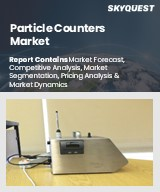
세계의 파티클 카운터 시장 규모는 2023년에 4,203억 5,000만 달러에 달하며, 2024년 4,596억 9,000만 달러에서 2032년에는 9,404억 5,000만 달러로 성장하며, 예측 기간(2025-2032년) CAGR은 9.36%로 성장할 전망입니다.
파티클카운터 시장은 제약 분야의 확대와 엄격한 규제 요건으로 인해 강력한 성장세를 보이고 있습니다. 주요 기업의 전략 강화는 기술 발전과 R&D 투자 증가와 함께 시장 확대를 더욱 촉진하고 있습니다. 실시간 모니터링을 위한 IoT 통합 개선, 다양한 용도를 위한 소형화, 에너지 효율적 설계를 통한 지속가능성 강조 등 새로운 동향이 업계를 재편하고 있습니다. 시장은 규제 강화와 생물제제 제조 증가로 헬스케어, 클린룸 등의 분야로 다변화되고 있습니다. 그러나 높은 비용과 컴플라이언스의 복잡성 등의 문제가 시장 침투에 걸림돌로 작용하고 있습니다. AI 기술은 실시간 데이터 분석, 이상 감지, 예지보전을 용이하게 함으로써 오염 관리 프로세스의 높은 정확도와 효율성을 보장하여 이 시장을 크게 강화하고 있습니다.
Global Particle Counters Market size was valued at USD 420.35 Billion in 2023 and is poised to grow from USD 459.69 Billion in 2024 to USD 940.45 Billion by 2032, growing at a CAGR of 9.36% in the forecast period (2025-2032).
The particle counters market is experiencing robust growth, driven by the expanding pharmaceutical sector and stringent regulatory requirements. Enhanced strategies from key players further propel market expansion, alongside technological advancements and increased R&D investments. Emerging trends such as improved IoT integration for real-time monitoring, miniaturization for diverse applications, and a focus on sustainability through energy-efficient designs are reshaping the industry. The market is diversifying into sectors like healthcare and cleanrooms due to stricter regulations and rising biologics manufacturing. However, challenges such as high costs and compliance complexities hinder market penetration. AI technology is significantly enhancing this market by facilitating real-time data analysis, anomaly detection, and predictive maintenance, thereby ensuring higher accuracy and efficiency in contamination control processes.
Top-down and bottom-up approaches were used to estimate and validate the size of the Global Particle Counters market and to estimate the size of various other dependent submarkets. The research methodology used to estimate the market size includes the following details: The key players in the market were identified through secondary research, and their market shares in the respective regions were determined through primary and secondary research. This entire procedure includes the study of the annual and financial reports of the top market players and extensive interviews for key insights from industry leaders such as CEOs, VPs, directors, and marketing executives. All percentage shares split, and breakdowns were determined using secondary sources and verified through Primary sources. All possible parameters that affect the markets covered in this research study have been accounted for, viewed in extensive detail, verified through primary research, and analyzed to get the final quantitative and qualitative data.
Global Particle Counters Market Segments Analysis
Global particle counters market is segmented by product, modality, application, end user and region. Based on product, the market is segmented into airborne particle counters, liquid particle counters, and others. Based on modality, the market is segmented into handheld, portable, and remote. Based on application, the market is segmented into cleanroom monitoring, contamination monitoring of liquids, indoor air quality monitoring, chemical contamination monitoring, and others. Based on end user, the market is segmented into pharmaceutical and biotechnology companies, clinical and diagnostic laboratories, academic and research institutes, contract research organizations (CROs), and others. Based on region, the market is segmented into North America, Asia-Pacific, Europe, Latin America, and the Middle East and Africa.
Driver of the Global Particle Counters Market
One of the key market drivers for the global particle counters market is the increasing demand for cleanroom and controlled environment monitoring across various industries, including pharmaceuticals, semiconductor manufacturing, and biotechnology. These sectors prioritize air quality and contamination control to ensure product safety and regulatory compliance. As stringent regulations and quality standards continue to evolve, companies are investing in advanced particle counting technologies to monitor airborne particles and maintain optimal environmental conditions. The growing awareness of health concerns related to airborne contaminants also fuels demand for effective monitoring solutions, propelling the growth of the particle counters market worldwide.
Restraints in the Global Particle Counters Market
One significant market restraint for the global particle counters market is the high cost associated with advanced particle counting technologies. These sophisticated instruments often require substantial investment in terms of both initial purchase and ongoing maintenance, which can deter small and medium-sized enterprises from adopting such solutions. Additionally, the technical expertise required to operate and interpret data from these instruments adds another layer of complexity and cost. This financial barrier can limit market accessibility and slow down the adoption of particle counters in various industries, impacting overall market growth and expansion.
Market Trends of the Global Particle Counters Market
The Global Particle Counters market is witnessing a significant trend towards the integration of AI and IoT technologies, revolutionizing traditional measurement approaches. This advancement enables real-time monitoring and predictive maintenance, enhancing the accuracy and reliability of particle detection. By automating alarm systems and facilitating compliance through remote access, these innovations streamline operations for various industries, including pharmaceuticals, environmental monitoring, and cleanroom applications. Enhanced data analytics through consolidated dashboards offer deeper insights into air quality and contamination levels, ultimately driving demand for smarter, more efficient particle counters that meet the evolving needs of regulatory compliance and industry standards.